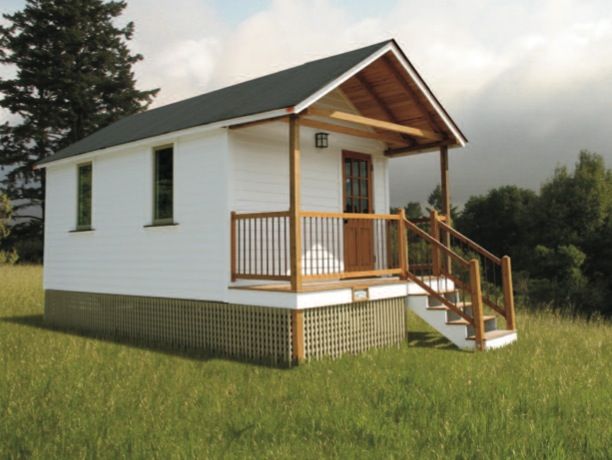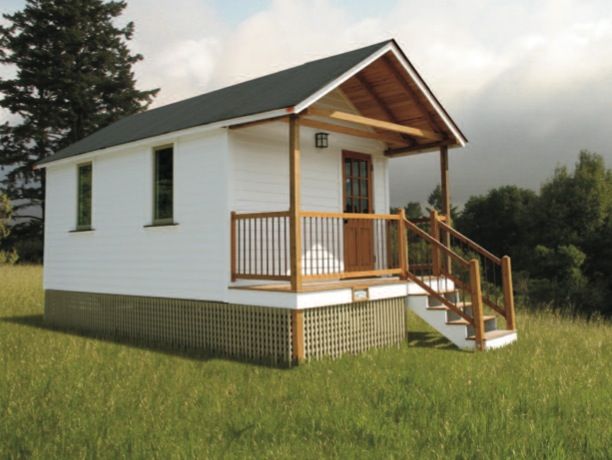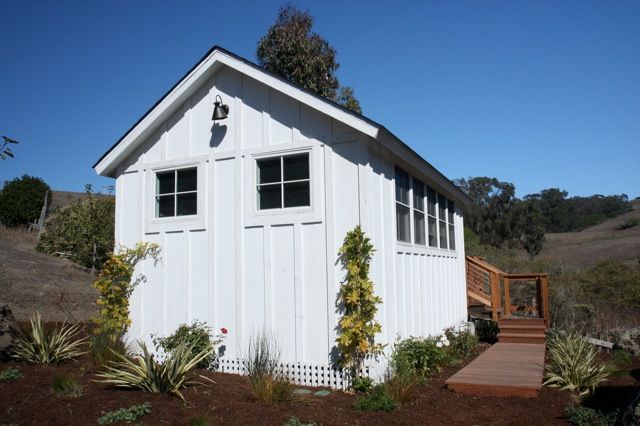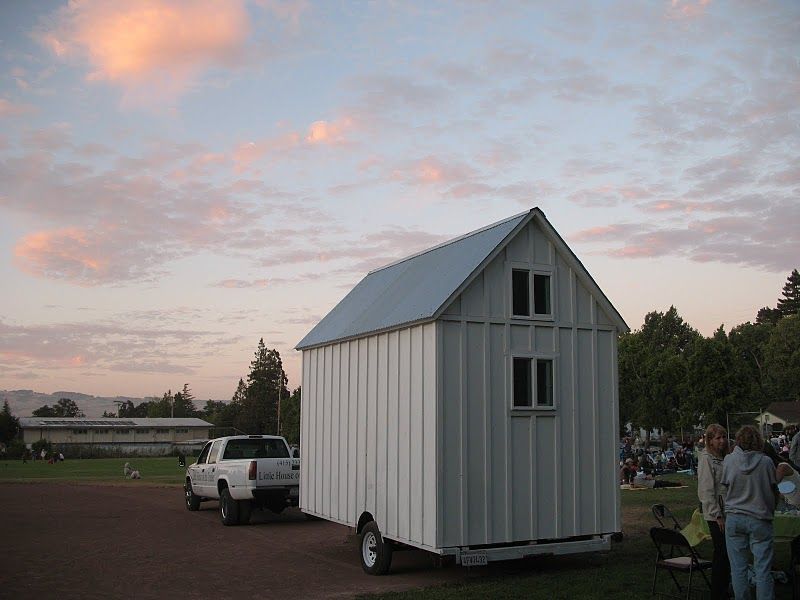Caregiver Cottages, Home Offices, and Studios To Go?

It would look perfectly at home on a prairie, next to an apple tree in a Thornton Wilder play, or tucked among the wind-wracked cypresses along northern California’s coast. In fact, you could easily move Steve Marshall’s 19th-century inspired farm house to any choice piece of land-including your own back yard-because the house is mounted on a trailer.
In addition to being mobile, the little house is seriously cute, even sitting by a road in my rural home town, Point Reyes. The morning I happened by, I was hell-bent to get coffee, but had to have a look. I poked around for maybe ten minutes, during which time several women also wandered through. Judging from the sounds they made-sounds that my beloved makes when she sees chocolate or cute shoes-they loved the house.
And despite my pre-caffeinated crankiness, even I had to admit it was well done. Outside, there’s a nice balance of white paint and natural wood. The proportions are beautiful. The porch is wide and inviting. Every hand rail, stair tread and board edge is lovingly chamfered. Copper pipe balusters glow warmly, as do copper-clad door and window sills. It’s as tight as a boat. You couldn’t slip an ace between the clapboards and trim, and the stainless steel screws on the porch decking line up like marching bands. This mania for detail even extends to the sage green paint-shades of Martha Stewart!-used as accents inside and out, including a hand-lettered sign that says,
Little
House
on the
Trailer
For Sale
$60,000
The price also includes red road reflectors at each corner and a California license plate. Priced to move, so to speak.
Home with all the trimmings
If anything, the interior of The Little House on the Trailer is even more ambitious. In roughly 200 sq. ft., Marshall has accommodated a large room with wainscoting, chair rails and crown molding, with the same eye for color and joinery as the exterior; a conventional RV propane heater set in a period mantelpiece, with a surround of punched tin “tiles”; a small all-in-one kitchen unit; an incinerating toilet; and, out the back door, an outdoor shower.
Yet for all the stuff inside the little house, it feels roomy and bright. Much of the credit for that goes to its 10 ft. high cathedral ceiling-something you don’t often see in an RV-and a generous number of windows. But the show-stopper is the house’s fir flooring. Recycled from the cookhouse of a land-grant farm in nearby Novato, the fir has the color of honey and the feeling of home.
When I finally met Steve Marshall, later that week, it was no surprise that he’s been a cabinetmaker for more than 30 years. He even sounds like a woodworker, thoughtful and exact in his speech. So what prompted such a methodical man to build such a charming oddity, a turn-of-the-century farm house on wheels?
Economics and aesthetics
“I guess I arrived at the concept from several directions,” Marshall said. “First of all I wanted the house to feel right. The architecture of, say, Point Reyes in 1910 defines so much of this area. It was the peak of the railroad era, yet it was also a period in which life hadn’t changed all that much from a hundred years before it. There was a sense of continuity. So when I arrived here in 1973 and worked as a carpenter for several years, it really felt like I’d come home.”
“And the trailer…?” I prodded.
“Well,” he continued, “that probably grew out the years I knocked around, learning my craft. For the longest time, I knew that a mobile home had it all-except the aesthetics. So I wondered about applying different surface treatments to the mobile home-windows, nice doors, wood trim and other civilizing touches. When I started buying lots and building real houses, my fascination with mobile homes receded, but it was probably bubbling in the background all the while.”
“So what brought it to the surface?”
“Economics. The economics-and logistics-of building anything in Marin County are unbelievable. A simple addition can easily cost $100,000 or $150,000 and what with all the permit compliance, can take two years to complete. On the other hand, my crew and I can turn around a little house in six weeks once the homeowners decide what finish details they want. It’s completely customizable. And since it’s delivered complete to the site, there’s no on-site construction to rile up the neighbors.
“Plus there’s a element of freedom that’s appealing. If you want a writing studio or a home office, or a place to put up company, or a satellite building to park your kid in for several years before he or she goes off to college…it’s a great solution. Later on, if you want to move it to another part of your property or even sell it, you’re free to do so.”
And moving it?
Moving on, moving in
“Moving it is easy, “Marshall said. “There are a litany of things the county requires, but the move was simpler than I imagined. Permits included, it took about $2,000 and a half day to move and set up the house. Technically, the little house is a recreational vehicle (RV), but because the house and trailer together weigh less than 10,000 pounds, you don’t even need a commercial chauffeur’s license to move it.”
I was just beginning work on a new book on second units (In-laws, Outlaws, and Granny Flats) so my brain was spinning. Could this little house be used an in-law?
Not surprisingly, Marshall’s answer was careful: “As far as local zoning codes, anyone can park an RV on their property. Living in the vehicle, while proscribed by local codes, is something of a gray area in practice. As long is it’s not an occupied residence, it’s legal, but out in the sticks usually no one is looking. The closer you are to civilization, the more you’re at the pleasure of your neighbors. So while the law is specific, its application varies from neighborhood to neighborhood.”
Marshall pointed out that the majority of the Little Houses he sells are for day uses such as yoga, writing, or art studios, home offices and the like. He also noted that in unincorporated Sonoma County, little houses can be used for Home Care Units for people who need care on their property. As Marshall spoke, I recalled a fall my mother took. Elderly people are prone to sudden mishaps such as falling and breaking a hip and the Little House’s quick turn-around time could be a blessing in such an emergency. It would be hard to imagine anyone–including neighbors–objecting to care for a family member.
In his quiet way, Steve Marshall summed it all up, “Ultimately, it has to do with respect for your neighbor. If you are not imposing on them and you’re moving in something they find pleasing or necessary, chances are good that things will work out.”
Create Your Own In-Law!
If you’re interested in second units, please check out my recent book, Outlaws and Granny Flats: Your Guide to Turning One House into Two Homes. The Library Journal named it one of the 10 Best Design Books for 2011. You can also preview In-laws, Outlaws‘ lush professional photos at www.cozydigz.com
If you will be renovating your home (or perhaps creating an in-law suite), there’s no better companion than Renovation 4th Edition, (November, 2012). Its 614 pages, 1,000 photos and 250 detailed illustrations cover home renovation from start to finish and contain lifetimes of practical, field-tested techniques that professional builders shared with me over a 40-year period.
© Michael Litchfield 2012
Fine Homebuilding Recommended Products
Fine Homebuilding receives a commission for items purchased through links on this site, including Amazon Associates and other affiliate advertising programs.

Homebody: A Guide to Creating Spaces You Never Want to Leave

Graphic Guide to Frame Construction

Get Your House Right: Architectural Elements to Use & Avoid































View Comments
vhello everyone,im wholesale supplier online
Welcome to our website
===== http://www.goodshopping.us/ =======
accept paypal or credit card and free shipping
We need your support and trust!!!
Dear friends, please temporarily stop your footsteps
To our website Walk around A look at
Maybe you'll find happiness in your sight shopping heaven and earth
You'll find our price is more suitable for you.
=== http://www.goodshopping.us/ =====